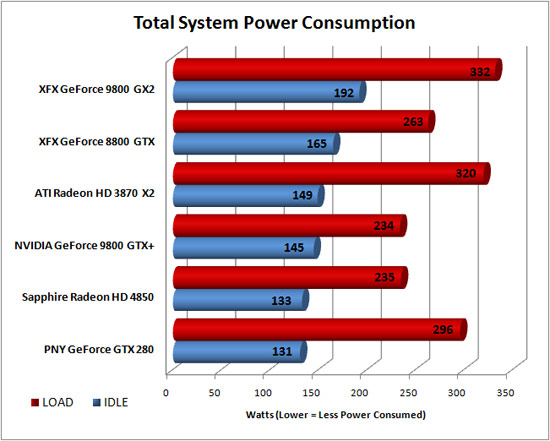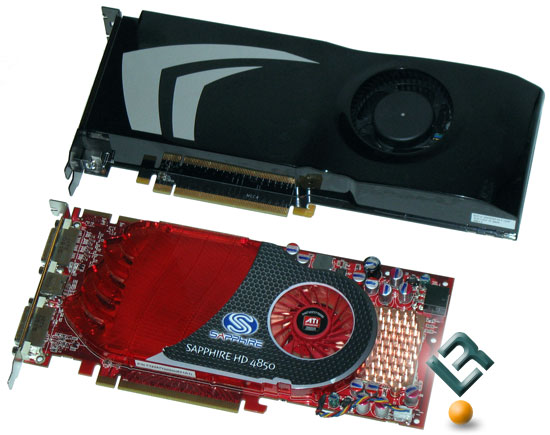ATI Radeon HD 4850 Versus NVIDIA GeForce 9800 GTX+
Power Consumption and Final Thoughts
Power Consumption
For testing power consumption, we took our test system and plugged it into a Seasonic Power Angel. For idle numbers, we allowed the system to idle on the desktop for 15 minutes and took the reading. For load numbers, we measured the peak wattage used by the system while running the game Call of Duty 4 at 1280×1024 with high graphics quality.

Power Consumption Results: Looking at total system power consumption levels, the GeForce 9800 GTX+ and Radeon HD 4850 use roughly the same amount power at load. At idle the Sapphire Radeon HD 4850 was a little more energy friendly as it should be. Remember the Sapphire Radeon HD 4850 consumes 110W at most.

Final Thoughts
The past 24 hours has been nothing but a blur of testing, but we wanted to get this review out to you as soon as possible. ATI and NVIDIA have done a great job on the Radeon HD 4850 and GeForce 9800 GTX+ graphics cards with both being hands down better than the generation they replace. We originally had some issues installing the drivers for the Radeon HD 4850, but we got them sorted out this morning with ATI. Having less than 24 hours to benchmark and publish a video card article is pretty nuts, but we managed to pull it off on two different cards this time around and were able to include overclocking results as well. We will be bringing you CrossFire and SLI performance numbers next week when the original launch was scheduled, so hang tight if you are wanting multi-GPU performance numbers.
The ATI Radeon HD 4850 is sure to be a price versus performance champ as the MSRP is $199 and will certainly go lower just like the Radeon HD 3850 did after it was launched. For those wanting more power ATI is getting the Radeon HD 4870 ready and with GDDR5 memory and faster clock speeds it is rumored to be 10-20% faster than the Radeon HD 4850, but it will cost you more. Many places are currently selling the Radeon HD 4850, so this is a card you can actually go out and buy today if you really wanted one. The single-slot design is a winner with many users, but the card runs toasty at nearly 80C while on the open test bench. Many add-in-board (AIB) partners will likely put dual slot coolers on this card if they want to allow customers to overclock them much over stock frequencies.
Just days ago we showed that the GeForce GTX 280 was the fastest single GPU video card that we have ever tested and a few days later they ship us this mainstream part that caught us off gaurd. The NVIDIA GeForce 9800 GTX+ was designed to be a spoiler to ATI’s Radeon HD 4850/4870 and it might have done the job. The GeForce 9800 GTX+ was faster in the majority of the benchmarks we tested it on and it had a tad more overclocking head room than the ATI Radeon HD 4850 did. The MSRP on the GeForce 9800 GTX+ is $229 and with NVIDIA enforcing UMAP pricing it’s likely that they won’t go much below that figure. The other downside to the GeForce 9800 GTX+ is that you can’t buy it now as you’ll have to wait until July 2008 to get one. The good news is that NVIDIA has made the move to 55nm and it looks like they pulled it off. The thermal temperatures were looking good and the power consumption levels are down from the previous 65nm generation. The ace that NVIDIA has is PhysX support starting right now. ATI of course has support with HAVOK, but where are the drivers? For an extra $30 consumers can go with the GeForce 9800 GTX+ and get more performance, PhysX game support and run more CPU computing applications or run the faster (BadaBoom and Folding@home).
Legit Bottom Line: The ATI Radeon HD 4850 and GeForce 9800 GTX+ rasie the bar for graphics cards and perform better than one would expect for a $199-$229 product. Enthusiasts and gamers better start saving some money up because you’ll want one of these before summer is over.
UPDATE (6-21-2008 at 2PM CST):
NVIDIA just informed us that the official launch date for the GeForce 9800 GTX+ is July 16th. They also wanted to share that overclocked 9800 GTX cards are currently available on the market today that deliver virtually identical performance as the 9800 GTX+. So if any of our readers want one today, they can pick one up from video card companies like EVGA and XFX have overclocked versions. Pricing on the 9800 GTX has dropped has dropped the past few days and those cards can now be found for as little as $199.99. Based on our new overclocking results it might be worth the wait though.

Comments are closed.